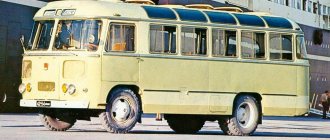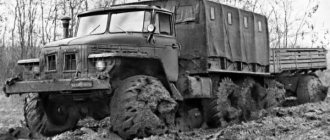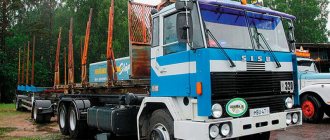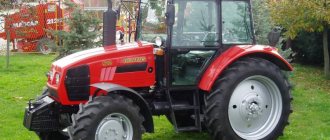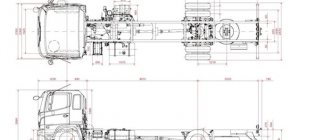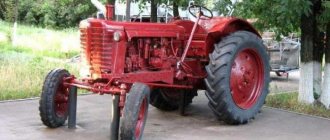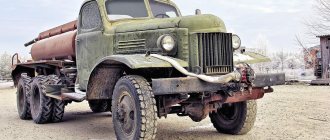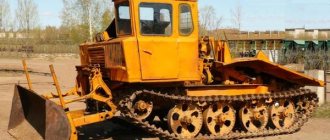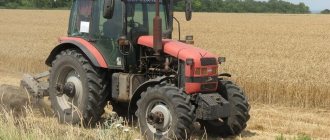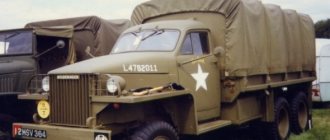City bus MAZ-104. Photo Wikipedia
MAZ-104 is a Belarusian large-class city bus manufactured by the Minsk Automobile Plant. Designed for large cities with intense passenger traffic. It was developed as a cheaper and unpretentious high-floor version of the basic semi-low-floor bus of the MAZ-103 family. To achieve their goals, the developers used the YaMZ-236 engine and unified other components of the bus with MAZ trucks, but at the same time they had to abandon the low-floor design. The engine in all modifications is located in the rear overhang. The number of seats varies from 24 to 40 pieces, depending on the order. The total passenger capacity is 100 people.
History of creation, detailed description, device
The MAZ-104 city bus has been produced by the Minsk Automobile Plant (Minsk, Belarus) since 1997. The history of this bus began in the mid-90s (when the model project was being developed) and it developed in parallel with the MAZ-103.
City bus MAZ-104. Photo Wikipedia
On May 23, 1996, Order No. 308 appeared, signed by General Director V.A. Gurinovich, “On putting into production the MAZ-104 city bus.” It said that this was being done “ in order to expand the range of manufactured buses , to most fully satisfy consumer requirements, as well as to master the production of cheaper bus models.” The task was first to produce two pilot industrial models of buses: in the urban version - MAZ-104 and in the suburban version - MAZ-104S. And then in the second half of the year, organize their industrial production. The floor level of the 104th is 700 mm. exceeded the same figure for the 103rd, additional steps for passengers to enter and exit. These design solutions made it possible to maximally unify the drive axle and front axle of the new model and other components and mechanisms with serial units used on trucks of the Minsk Automobile Plant.
The buses were equipped with V-shaped 6-cylinder 230-horsepower YaMZ-236 engines produced by the Yaroslavl association "Avtodiesel" with a mechanical 5-speed YaMZ-236L gearbox or a 4-speed automatic Voith "Diwa".
But even before the creation of MAZ-104, on the instructions of the previous general director of the enterprise, G.A. Isaevich, the bus branch produced a single copy of the MAZ-102 bus. A 6-cylinder in-line MMZ-D260.5 with a power of 230 hp was used for it. But this diesel engine did not catch on; it was replaced by a Yaroslavl diesel engine, well known to consumers, and some changes were made to the design, taking into account the tests carried out. Instead, the MAZ-104 appeared, with a passenger capacity of 90-100 people . On the first copies of the bus, the fan was positioned along the rear axis. Therefore, their radiator was located at the rear. But the blowing system turned out to be ineffective. And he was carried on board.
MAZ-104 was the most affordable model of Minsk buses. The bus used components from serial MAZ trucks, which had a positive effect on its price (8-10 thousand dollars cheaper than the similar MAZ-103). However, the use of “cargo” axles and more affordable engines and gearboxes produced by the Yaroslavl Motor Plant forced the designers to abandon the low floor, which creates some inconvenience when operating the bus in urban conditions. MAZ-104S is a suburban version of the base model 104 and differs only in the absence of a rear door, a different interior layout (the number of seats is 40) and a different drive axle ratio
The body is all-metal, carriage type, load-bearing. The sides and roof were made of seamless galvanized steel sheet, the front part was made of fiberglass. The glass is glued in, which has a positive effect on the rigidity of the body. It had three sliding doors (two double doors for passengers, the rear half of the front door, the front half of the front door for the driver). The driver's cabin was fenced off from the passenger compartment as standard. The bus was equipped with a traffic lock when the doors are open, which is turned off by a button with the symbol (B) on the front panel in the driver’s cabin.
On buses of the MAZ family, two types of route indicators - an electronic board and route indicators with replaceable route signs. The front route indicator is located on the front of the bus above the windshield, the side route indicator is located above the side windows between the front and middle doors, the rear route indicator is on the back of the bus above the rear window.
Bus MAZ-104. Photo Wikipedia
The MAZ-104 was equipped with non-removable hard passenger seats . two types of hard seat fastenings used on buses . In both cases, the seat is bolted to the stand. In the first case, the stand is screwed to the wheel arch or to the step of the engine compartment. In the second case, the stand mount is mounted with one side on the side wall, and the other side through the stand to the floor. The handrails were made of metal pipes coated with powder paint. The handrail pipes were connected with aluminum brackets, which were fastened with screws.
The bus had a three-row layout. On the left side there were double seats. On the starboard side - single. Opposite the middle door there was a large storage area. The total passenger capacity is 100, the number of seats is 21-28.
On the MAZ-104, the power unit was located at the rear along the longitudinal axis of the bus. The power unit was attached to the bus frame at three points (one front and two side). In addition, there was a fourth gearbox support mount. When the engine was not running, the rear support should not have taken the load. To fulfill this condition in operation, it was possible to adjust the rear support . This was necessary to prevent the occurrence of large stresses in the crankcase parts of the power unit.
Separated fuel supply system for the engine It consisted of a fuel tank, low and high pressure fuel lines, a coarse filter, a fuel priming pump, a fine filter, a high pressure fuel pump and injectors. The fuel tank was installed on the right side along the bus in a niche and was attached to the frame with clamps. Polyamide low-pressure fuel lines were placed in protective shells and fastened with clamps to the frame. At the customer's request, electric fuel heating could be installed in the engine fuel supply system.
The air supply system of the YaMZ-236M2 engine consisted of an intake connected to the air filter by an angle pipe and an air duct connecting the air filter and the engine intake manifold. To monitor the clogging of the air filter element, there was a clogging warning sensor . YaMZ-236NE engines have a turbine for air injection. The air filter used in this system is dry type, two-stage, with a dust collection hopper and a replaceable cardboard filter element.
The cooling system is liquid, closed type, with forced circulation of coolant, designed for the use of low-freezing coolant. The engine cooling system was combined with a heating system for the interior and driver's workplace . On buses equipped with a YaMZ-236M2 engine with a non-switchable gear fan drive, in addition to adjusting the thermal conditions of the engine, a radiator shutter was installed , which can be fixed in any position (the shutter is controlled from the engine compartment), as well as an oil radiator, which served to cool the oil in engine lubrication system. The oil radiator is tubular-plate, air-cooled, located in front of the water radiator.
MAZ bus model 104. Photo Wikipedia
Liquid heaters 14.8106, 141.8106 (Rzhev, Russia), Tur 268.07, Thermo 90S (Webasto) could be installed on the buses for pre-heating of the engine , which facilitates cold starting of the engine, as well as for long-term maintenance in automatic mode of the thermal state of an idle engine, bus interior and driver's seat. To maintain the required thermal conditions of the engine, bus interior and driver's seat, the heater was allowed to operate simultaneously with the engine while the bus was moving. The heater was supplied with fuel through separate fuel lines from the main fuel tank. The power supply system for the fuel heaters could, at the customer's request, be equipped with an electric fuel heating system (supply voltage 24 V DC). The electric fuel heating system consisted of an electric heater, a fuel intake, fuel lines and a fuel filter.
The fuel supply control drive for YaMZ-236 engines was a cable drive with a pneumatic amplifier. The need to install a pneumatic booster is due to significant forces on the injection pump lever.
The YaMZ-238 clutch is a double-disc, dry, friction type, with a peripheral arrangement of cylindrical springs. MAZ buses use hydraulic and mechanical clutch drives with pneumatic assistance.
The YaMZ-236L, YaMZ-236P gearbox is mechanical, three-way, five-speed, with synchronizers in all forward gears. The YaMZ-238M gearbox is a mechanical, 8-speed three-shaft main gearbox with a 2-speed shaft range, with synchronizers in all forward gears. The gearbox control drive is remote, mechanical. It consisted of a gear shift lever mounted on the floor of the bus and a transmission mechanism, including a shaft line suspended on sliding spherical supports, reaction rods and a device for coordinating the movements of the gear shift lever and the movements of the gear shift mechanism shaft.
, YaMZ-236 and MMZ-D-260.5 engines were installed on buses However, Minsk engines on the MAZ-104 (modification of MAZ-104.001) did not last long, as they had low power. In addition, the cargo axle and the Yaroslavl gearbox with an engine have long been a proven scheme for the Mazovians. Externally, buses with an MMZ engine can be recognized by a larger number of horizontal slots for cooling the engine compartment and, of course, by the characteristic “whining” sound during acceleration.
But Yaroslavl engines are widely used on Minsk buses. They had good torque, and besides, the question of choosing a gearbox disappeared automatically: the YaMZ-236 engine was ideally suited to the YaMZ-236L gearbox designed for it.
From the end of 2004 to the beginning of 2005. Buses with turbocharged YaMZ-236NE engines began to arrive in Minsk . These engines are distinguished by an enviable torque of 882 N*m and a power of 230 hp. Buses can be easily distinguished by additional grilles on the rear pillars and a rectangular muffler pipe.
Now it’s the turn of the MAZ-104 and its suburban modification MAZ-104S to go down in history. Both models were discontinued in 2007. The main reason: the inconsistency of Russian engines with modern European requirements. And other power units are not provided for them. And according to factory marketing data, the demand for these buses has sharply decreased.
History and description
The MAZ-104 city bus has been produced by the Minsk Automobile Plant (Minsk, Belarus) since 1997.
The MAZ-104 bus is the most affordable model of Minsk buses. The bus uses components from serial MAZ trucks, which has a positive effect on its price (8-10 thousand dollars cheaper than the similar MAZ-103). However, the use of “cargo” axles and more affordable engines and gearboxes produced by the Yaroslavl Motor Plant forced the designers to abandon the low floor, which creates some inconvenience when operating the bus in urban conditions.
The MAZ-104S bus is a commuter version of the base model 104 and differs only in the absence of a rear door, a different interior layout (the number of seats is 40) and a different drive axle gear ratio.
The bus body is all-metal, carriage type, load-bearing. The sides and roof are made of seamless galvanized steel sheet, the front part is made of fiberglass. The glass is glued in, which has a positive effect on the rigidity of the body. It has three sliding doors (for passengers, two double-leaf doors - the rear half of the front door, the front half of the front door - for the driver). The driver's cabin is fenced off from the passenger compartment as standard. The bus is designed to block traffic when the doors are open.
MAZ-104 buses are equipped with non-removable hard passenger seats. There are two types of hard seat fastenings used on buses. In both cases, the seat is bolted to the stand. Handrails are made of metal pipes coated with powder paint.
The door drive of MAZ buses is pneumatic. The body production technology is “Neoplan” - the frame is welded from box profiles and then sheathed with steel sheet. The wheel arches and part of the floor are covered with stainless steel sheets. The paint is polyurethane multicomponent. They mix it in their own laboratory. The color scheme is eye-catching. The color is selected at the request of the customer.
The bus has a three-row layout. On the left side there are double seats. On the starboard side - single. Opposite the middle door there is a large storage area. Total passenger capacity - 100. Number of seats - 21-28.
MAZ-104 is a completely modern car, equipped with ABS, PBS, tinted windows, a blinker display (with two-color rotary cells and LEDs), an on-board computer and more.
From the passenger's point of view, the interior is quite good. The central aisle is 790mm wide and the door openings are 1250mm wide. The disadvantage for urban transport is the high floor level and very high steps at the rear door. The bus has a good heating system, and an automatic transmission ensures smooth acceleration and braking. The driver's workplace is also comfortable - good visibility, informative instruments, an additional stove.
Buses, in addition to electronic route indicators, are also equipped with speech systems, which means that, regardless of the driver’s oratory skills, the passenger will hear the stop he needs, and the driver will not have to strain his vocal cords.
The bus can operate using the “stop on demand” system, for which “exit request” buttons are installed above all doors, as well as on the sides between the front and middle doors.
The bus is designed in accordance with European standards, EEC directives and UNECE Regulations. Serially produced models have a “Vehicle Type Approval” certificate.
Specifications:
| Engines (all engines – 6-cylinder, V-shaped) | ||||
| YaMZ-236 M2 | YaMZ-236 NE/NE2 with turbocharging | |||
| Working volume, l | 11,15 | 11,15 | ||
| Compression ratio | 16,5 | 16,5 | ||
| Bore and stroke | 130*140 | 130*140 | ||
| Maximum power, hp (kW) at rpm | 180 (132) 2100 | 230 (169) 2100 | ||
| Maximum torque, N*m at rpm | 667 1250-1450 | 882 1200-1400 | ||
| Maximum speed, km/h | 85 (MAZ-104S -95) | 85 (MAZ-104S -95) | ||
| Gearboxes | YaMZ-236P/L | Mechanical, 5-speed, without synchronizer in reverse gear | ||
| YaMZ-238 | mechanical, 8-speed three-shaft main gearbox with 2-speed shaft range, with synchronizers in all forward gears | |||
| Suspension | Front | Independent, pneumatic, double-cylinder with two body position regulators | ||
| Rear | Dependent, pneumatic, four-cylinder with two body position regulators | |||
| Brakes | Worker | Pneumatic, with automatic adjustment of gaps between pads and drums, with ABS and ASR | ||
| Parking | On the rear axle mechanisms | |||
| Number of wheels | 6+1 | |||
| Tire size | 11.00/70R22.5 | |||
| Number of seats | 29 | |||
| Total number of seats | 89 | |||
| Total area intended for passengers, m | 21,2 | |||
| Area to accommodate standing passengers, m | 7,5 | |||
| Internal cabin height in the middle aisle, mm | 2260 | |||
| Height of the first step above the road level, mm | 360 | |||
| Floor height above road level, mm | 700 | |||
| Total weight, kg | 18000 | |||
| Axle load, kg | Front | 6500 | ||
| Average | 11500 | |||
| Length/width/height, mm | 12000/2500/3114 | |||
| Wheelbase, mm | 6000 | |||
| Axle tracks, mm | Front | 2000 | ||
| Rear | 1820 | |||
| Front overhang, mm | 2605 | |||
| Rear overhang, mm | 3380 | |||
| Ground clearance, mm | 300 | |||
| Outer turning radius, m | 11,3 | |||
| Front overhang angle, i-rad | 8 | |||
| Rear overhang angle, 1 rad | 8 | |||
| Longitudinal radius of passability, mm | 13040 | |||
| Ground clearance of the front overhang, mm | 251 | |||
| Rear overhang ground clearance, mm | 251 | |||
| Rear suspension ground clearance, mm | 229 | |||
| Ground clearance under axles, mi | 214 | |||
| Height of front towing device, mm | 507 | |||
| Rear towing device height, mm | 645 | |||
| The width of the corridor occupied by a bus when turning with an outer overall radius of 12.5 m, no more | 6,7 | |||
| External minimum overall turning radius, m, no more | 11,6 | |||
| Maximum incline overcome by a bus with full weight, %, not less | 30 | |||
| Fuel consumption, l/100km | 30 | |||
Modifications
Bus MAZ-104.X25. Photo Wikipedia
104.000 – basic urban modification, MMZ D-260.5 engine.
104.021 – urban modification, YaMZ-236NE-16 engine, YaMZ-236P manual transmission, 6 gears.
104.025 - urban modification, differs from .021 by the Voith Diwa D 854.3E automatic transmission.
104.031 is an urban modification, differs from .021 by a YaMZ-236M2 engine and the absence of turbocharging.
104.C00 - suburban modification, differs from .000 in the increased number of seats and the absence of a rear door.
104.С21 is a suburban modification, differs from .021 in the increased number of seats and the absence of a rear door.
104.C25 is a suburban modification, differs from .C21 by the Voith automatic transmission.
104.Х25 – urban modification. The northern version differs from the .025 in triple glazing of the windows, the YaMZ-236NE2-22 engine and the exhaust pipe on the roof, an unofficial special order for the Khanty-Mansiysk Autonomous Okrug.
MAZ-104 - review and history of the model
The MAZ-104 city bus has been produced by the Minsk Automobile Plant (Minsk, Belarus) since 1997. The history of this bus began ten years ago and it developed in parallel with the MAZ-103.
On May 23, 1996, Order No. 308 appeared, signed by General Director V.A. Gurinovich, “On putting into production the MAZ-104 city bus.” It said that this was being done “in order to expand the range of buses produced, to best meet consumer requirements, as well as to master the production of cheaper bus models.” The task was first to produce two pilot industrial models of buses: in the urban version - MAZ-104 and in the suburban version - MAZ-104S. And then in the second half of the year, organize their industrial production. The floor level of the 104 was 700 mm higher than that of the 103, and there were additional steps for passengers to enter and exit. These design solutions made it possible to maximally unify the drive axle and front axle of the new model and other components and mechanisms with serial units used on Minsk Automobile Plant trucks.
The buses are equipped with V-shaped 6-cylinder 230-horsepower YaMZ-236 engines produced by the Yaroslavl association "Avtodiesel" with a mechanical 5-speed YaMZ-236L gearbox or a 4-speed automatic Voith "Diwa".
But even before the creation of the MAZ-104, at the direction of the previous general director of the enterprise, G.A. Isaevich, the bus branch produced a single copy of the MAZ-102 bus. A 6-cylinder in-line MMZ D260.5 with a power of 230 hp was used for it. But this diesel engine did not catch on; it was replaced by a Yaroslavl diesel engine, well known to consumers, and some changes were made to the design, taking into account the tests carried out. Instead, the MAZ-104 appeared, with a passenger capacity of 90 people. On the first copies of the bus, the fan was positioned along the rear axis. Therefore, their radiator was located at the rear. But the blowing system turned out to be ineffective. And he was carried on board.
The MAZ-104 bus is the most affordable model of Minsk buses. The bus uses components from serial MAZ trucks, which has a positive effect on its price (8-10 thousand dollars cheaper than the similar MAZ-103). However, the use of “cargo” axles and more affordable engines and gearboxes produced by the Yaroslavl Motor Plant forced the designers to abandon the low floor, which creates some inconvenience when operating the bus in urban conditions. The MAZ-104S bus is a commuter version of the base model 104 and differs only in the absence of a rear door, a different interior layout (the number of seats is 40) and a different drive axle gear ratio
The bus body is all-metal, carriage type, load-bearing. The sides and roof are made of seamless galvanized steel sheet, the front part is made of fiberglass. The glass is glued in, which has a positive effect on the rigidity of the body. It has three sliding doors (for passengers, two double-leaf doors - the rear half of the front door, the front half of the front door - for the driver). The driver's cabin is fenced off from the passenger compartment as standard. The bus is equipped with a movement lock when the doors are open, which is disabled by a button with the symbol (B) on the front panel in the driver’s cabin.
On buses of the MAZ family, two types of route indicators are used - an electronic board and route indicators with replaceable route signs. The front route indicator is located on the front of the bus above the windshield, the side route indicator is located above the side windows between the front and middle doors, the rear route indicator is on the back of the bus above the rear window.
MAZ-104 buses are equipped with non-removable hard passenger seats. There are two types of hard seat fastenings used on buses. In both cases, the seat is bolted to the stand. In the first case, the stand is screwed to the wheel arch or to the step of the engine compartment. In the second case, the stand mount is mounted with one side on the side wall, and the other side through the stand to the floor. Handrails are made of metal pipes coated with powder paint. The handrail pipes are connected with aluminum brackets, which are tightened with screws.
On MAZ-104 buses, the power unit is located at the rear along the longitudinal axis of the bus. The power unit is attached to the bus frame at three points (one front and two side). In addition, there is a fourth transmission support mount. When the engine is not running, the rear support should not bear the load. To fulfill this condition in operation, it is possible to adjust the rear support. This is necessary to prevent the occurrence of large stresses in the crankcase parts of the power unit.
Separated fuel supply system for the engine. It consists of a fuel tank, low and high pressure fuel lines, a coarse filter, a fuel priming pump, a fine filter, a high pressure fuel pump and injectors. The fuel tank is installed on the right side along the bus in a niche and is attached to the frame with clamps. Polyamide low-pressure fuel lines are placed in protective shells and secured with clamps to the frame. At the customer's request, electric fuel heating can be installed in the engine fuel supply system.
The air supply system of the YaMZ 236 M2 engine consists of an intake connected to the air filter by an angle pipe and an air duct connecting the air filter and the engine intake manifold. To monitor the clogging of the air filter element, there is a clogging warning sensor. YaMZ-236 engines do NOT have a turbine for air injection. The air filter used in this system is dry type, two-stage, with a dust collection hopper and a replaceable cardboard filter element. The cooling system is liquid, closed type, with forced circulation of coolant, designed for the use of low-freezing coolant. The engine cooling system is combined with a heating system for the passenger compartment and driver's workplace. On buses equipped with a YaMZ 236 M2 engine with a non-switchable gear fan drive, in addition to adjusting the thermal conditions of the engine, a radiator shutter is installed, which can be fixed in any position (the shutter is controlled from the engine compartment), as well as an oil cooler, which serves to cool the oil in the system engine lubrication. The oil radiator is tubular-plate, air-cooled, located in front of the water radiator. Liquid heaters 14.8106, 141.8106 (Rzhev, Russia), Tour 268.07, Thermo 90S (Webasto) can be installed on buses. Liquid heaters are designed for pre-heating of the engine, which facilitates cold starting of the engine, as well as for long-term automatic maintenance of the thermal state of the idle engine, bus interior and driver's seat. To maintain the required thermal conditions of the engine, bus interior and driver's seat, the heater is allowed to operate simultaneously with the engine while the bus is moving. The heater is supplied with fuel through separate fuel lines from the main fuel tank. The power supply system for fuel heaters can, at the customer's request, be equipped with an electric fuel heating system (supply voltage 24 V DC). The electric fuel heating system consists of an electric heater, a fuel intake, fuel lines and a fuel filter.
The fuel supply control drive for YaMZ 236 engines is a cable drive with a pneumatic amplifier. The need to install a pneumatic booster is due to significant forces on the injection pump lever. The YaMZ 238 clutch is a double-disc, dry, friction type, with a peripheral arrangement of cylindrical springs. MAZ buses use hydraulic and mechanical clutch drives with pneumatic assistance.
The YaMZ 236 L, YaMZ 236 P gearbox is mechanical, three-way, five-speed, with synchronizers in all forward gears. The YaMZ 238 M gearbox is a mechanical, 8-speed three-shaft main gearbox with a 2-speed shaft range, with synchronizers in all forward gears. The gearbox control drive is remote, mechanical. It consists of a gear shift lever mounted on the floor of the bus and a transmission mechanism, including a shaft line suspended on sliding spherical supports, reaction rods and a device for coordinating the movements of the gear shift lever and the movements of the gear shift mechanism shaft.
Initially, YaMZ-236 and MMZ D-260.5 engines were installed on the buses. However, Minsk engines on the MAZ-104 (modification of MAZ-104.001) did not last long, as they had low power. In addition, the cargo axle and the Yaroslavl gearbox with an engine have long been a proven scheme for the Mazovians. Externally, buses with an MMZ engine can be recognized by a larger number of horizontal slots for cooling the engine compartment and, of course, by the characteristic “whining” sound during acceleration. There is at least one such machine in operation in Minsk - KM 3049, AP No. 1 (manufactured early 1997):
But Yaroslavl engines are widely used on Minsk buses. They had good torque, and besides, the question of choosing a gearbox disappeared automatically: the YaMZ-236 engine was ideally suited to the YaMZ-236L gearbox designed for it.
From the end of 2004 to the beginning of 2005. Buses with turbocharged YaMZ-236NE engines began to arrive in Minsk. These engines are distinguished by an enviable torque of 882 N*m and a power of 230 hp. Buses can be easily distinguished by additional grilles on the rear pillars and a rectangular muffler pipe. Such buses arrived at AP No. 4 (4 cars), 5 (2 cars), 6 (2 cars):
In 2005, Bus Park No. 4 received 2 MAZ-104 buses with YaMZ engines and an automatic 4-speed Voith transmission (these are KN 1800 and AA 0094-7). The new gearbox has improved the comfort of acceleration and braking, made the driver’s work easier, and reduced wear on the standard brakes.
Now it’s the turn of the MAZ-104 and its suburban modification MAZ-104S to go down in history. Both models are being discontinued this year. The main reason: the inconsistency of Russian engines with modern European requirements. And other power units are not provided for them. And according to factory marketing data, the demand for these buses has sharply decreased. As I was told at the 1st bus depot, drivers also don’t like the 104th because it is heavy and uncomfortable.
What will replace them? As for the MAZ-104 city bus, the plant will no longer produce similar vehicles. But the company is already looking for a replacement for the MAZ-104S.
Basic information, characteristics
Manufacturer/manufacturer where the equipment is produced/manufactured. OJSC Minsk Automobile Plant (MAZ) is a managing Soviet and Belarusian automobile manufacturing company specializing in the production of heavy-duty automobiles, as well as buses, trolleybuses and trailers.
Purpose. Urban.
Class. Big.
Body type. All-metal, carriage type, load-bearing.
Basic characteristics
- Body dimensions, mm. (LxWxH). 11985x2500x3056.
- Ceiling height in the cabin, mm. 2255.
- Front/rear wheel track, mm. 2053/1818.
- Height of step above road level, mm. 335.
- Floor height at the middle door landing, mm. 700.
- Passage width between seats, mm. 790.
- Front/rear overhang, mm. 2605/3380.
- Angle of front and rear overhang. 8.
- Number and dimensions of doors. 3 and 1250.
- Total number of seats, including landing seats. 100, including 23 landing.
- Type of seats. Separate rigid non-demountable with handrails.
Specifications
- Fuel type. Diesel.
- Fuel tank capacity, l. 220.
- Gross and curb weight, kg. 18000 and 12000.
- Load on front/rear axle based on technically permissible weight, kg. 6500/11500.
- Minimum turning radius, m. 11,3.
- Maximum incline overcome by a bus with full weight, %, not less. 30.
- Brake system. Working. Pneumatic, with automatic adjustment of gaps between pads and drums, with ABS and ASR Parking. On the rear axle mechanisms.
Engine/powertrain characteristics
- Brand. YaMZ-236NE; YaMZ-236NE-16; YaMZ-236NE2-22; MMZ D-260.5.
- Type. Diesel.
- Number and arrangement of cylinders. 6V.
- Environmental safety standards. Euro-2.
- Working volume, l. 11,15.
- Engine power, hp/min. 231 at 2100 rpm.
- Maximum torque, Nm/min. 667.
- Engine location. Rear.
- Gearbox model. YaMZ-236P; MAZ-306; KamAZ-14; Renault g406.0; VOITH Diwa 851.2.
- Checkpoint. Automatic or mechanical.
- Front-rear axle suspension. Pneumatic dependent-pneumatic dependent.
- Control fuel consumption at 60 km/h, l/100 km. 25.
- Maximum speed, km/h. 85.
- Pre-heating. Present.
Spare parts for Buses MAZ-104S
The Minsk Automobile Plant began producing the MAZ-104S bus in 2006. Wheel formula 4x2. The Belarusian large-class city bus MAZ-104S is widely used for transporting passengers in large cities with intense passenger traffic. This model was developed as a cheaper and also unpretentious high-floor version of the base bus from the MAZ-103 family. The design of the buses included the YaMZ-236 engine and components of MAZ trucks. Later, because of this, the developers had to abandon the low-floor design. The power unit in all modifications of the MAZ-104 models was located in the rear overhang. The number of seats can vary from 24 to 40, and the passenger capacity is 100 people. On the website you can buy MAZ-104 spare parts in a special catalog.
MAZ-104S has many different modifications, the designs of which differ from each other in engines, gearboxes, increased number of seats, rear door, etc. The MAZ-104 bus can be equipped with ABS, an independent heater, tinted windows, an information display and plastic seats. Modifications: MAZ-104S, MAZ-103S41, MAZ-104S21, MAZ-104S-021, MAZ-104S31, MAZ-104S-031, MAZ-104S20, MAZ-104S-020, MAZ-104S22. Thanks to our MAZ-104S spare parts catalog, you can easily find all the spare parts you need, because using the catalog is easy and convenient.
Purpose: Suburban Total weight of the bus, kg: 18000 Distribution of total weight on the front axle, kg: 6,500. Distribution of total weight on the rear axle, kg: 11500. Number of seats: 33-45. Nominal (maximum) capacity. people 123. Engine: YaMZ-236NE. Engine power, kW (hp): 169 (230). Maximum torque, Nm: 900. Gearbox: YaMZ-236P, MAZ-306, KamAZ-14, Renault g406.0, ZF 4hp 500 Ecomat, VOITH “Diwa” 851.2. Number of gearbox gears: 6. Front (rear) axle suspension: Dependent. Tires: 295/80 R22.5 tubeless, 11.00 R20 tubed. Maximum speed, km/h: 95. Control fuel consumption, l/100 km at V=60 km/h: 30. Fuel tank, l: 220. Working volume, l: 11.15. Cylinder arrangement: V-shaped. Rear axle: rigid beam with double spaced gear. Disc wheels: 8.25x22.5. Tire size: 11/70R22.5. Characteristics of roads: categories I and II. Ambient temperature: from -25C to +35C. Wheel formula: 4x2. Number of doors: 2. Height of steps above road level, mm: 335. Height of the floor on the middle door landing, mm: 700. Width of the passage between the seats, mm: 560.
Our specialists will advise you on all questions and tell you about all the MAZ-104S spare parts that are right for you. By purchasing spare parts from Dynamics 76, you are guaranteed to purchase high-quality parts for MAZ.
Features/Benefits
- The MAZ-104 bus is designed to ensure uninterrupted transportation of passengers on city routes. The safety and stability of MAZ buses on the road is increased due to light steering, welded body frame, durable air suspension, shock absorbers and a reliable braking system. ABS and PBS are installed as standard.
- An efficient heating system allows for rapid heating, cooling and maintaining the required temperature in the driver’s cab and passenger compartment; Ventilation hatches are installed in the body roof to meet the requirements for emergency exits.
- MAZ-104 is the optimal model for operation in a city with an average population density.
The MAZ-104 city bus was produced by the Minsk Automobile Plant (Minsk, Belarus) from 1997 to the end of 2006.
The year of birth of bus production at the Minsk Automobile Plant can be considered 1992, when a license agreement was signed with Neoplan (Germany, now the company belongs to the MAN concern). As a result, only five licensed buses were built in “pure form” (their price was prohibitive, about $200,000). And then the plant began to introduce domestic components, at the same time adapting the design to our conditions. For example, the plant was unable to organize the production of a portal drive axle - and therefore had to make the bridge simpler, and at the same time raise the floor in the rear part of the cabin by 8 cm. Today, the share of imports - excluding the power unit - does not exceed 8 percent (these are glue, varnishes, paints, plastic, brake equipment, door opening mechanisms). However, now the price of low-floor MAZ-103 buses in the basic configuration is about 40% of the original price.
The MAZ-104 bus was the most affordable model of Minsk buses. The bus uses components from serial MAZ trucks, which has a positive effect on its price (it is about 10 thousand dollars cheaper than the similar MAZ-103). However, the use of “freight” axles and more affordable engines and gearboxes produced by the Yaroslavl Motor Plant forced the designers to abandon the low floor, which creates some inconvenience when operating the bus in urban conditions. The MAZ-104S bus is a commuter version of the base model 104 and differs only in the absence of a rear door, a different interior layout (the number of seats is 40) and a different drive axle ratio (see summary table for MAZ buses).
Bus body and interior
The body of the MAZ-104 bus is all-metal, carriage type, load-bearing. The sides and roof are made of seamless galvanized steel sheet, the front part is made of fiberglass. The glass is glued in, which has a positive effect on the rigidity of the body. It has three sliding doors (for passengers, two double-leaf doors - the rear half of the front door, the front half of the front door - for the driver). The driver's cabin is fenced off from the passenger compartment as standard. The bus is equipped with a movement lock when the doors are open, which is disabled by a button with the symbol (B) on the front panel in the driver’s cabin.
On buses of the MAZ family, two types of route indicators are used - an electronic board and route indicators with replaceable route signs. The front route indicator is located on the front of the bus above the windshield, the side route indicator is located above the side windows between the front and middle doors, the rear route indicator is on the back of the bus above the rear window.
MAZ-104 buses are equipped with non-removable hard passenger seats. There are two types of hard seat fastenings used on buses. In the first case, the stand is screwed to the wheel arch or to the step of the engine compartment. In the second case, the stand mount is mounted with one side on the side wall, and the other side through the stand to the floor. Handrails are made of metal pipes coated with powder paint. The handrail pipes are connected with aluminum brackets. The seats are arranged in a three-row pattern, which makes the bus interior spacious for seated passengers.
The bus has a three-row layout. On the left side there are double seats. On the starboard side - single. Opposite the middle door there is a large storage area. The total passenger capacity is 100 people. The number of seats is 21-29.
The MAZ-104S bus has a four-row interior layout, and the central aisle after the second door has steps. The number of seats is up to 40.
The door drive of MAZ buses is pneumatic, usually manufactured by Festo. The drive is equipped with an emergency opening valve inside the bus above the door and an emergency opening valve outside, on the side of the doors.
The body production technology was borrowed under license from the German company Neoplan - the frame is welded from box profiles and then sheathed with steel sheets. Frame blanks - galvanized rectangular pipes - are fixed on a large sheet in special jigs. This is how the sides, floor and ceiling are welded. On the slipway they are combined into a single whole. The wheel arches and part of the floor are covered with stainless steel sheets. The paint is polyurethane multicomponent. They mix it in their own laboratory. The color is selected at the request of the customer from a huge number of colors and combinations.
The driver's cabin is quite spacious. The controls are located well and do not overlap each other. In front of the driver there is an instrument panel on which there is a speedometer (from the well-known company VDO), a voltage indicator, pressure gauges, tachometers, coolant temperature and oil pressure indicators, as well as a buzzer. To the right of the instrument panel there are buttons for controlling lights, doors, announcing current/next stops, controlling the transmission (if automatic is installed), differential locking, stopping brake control, and an hazard warning button. To the left of the instrument panel there are buttons for controlling light, ventilation and other bus systems.
The drawing shows a general view of the driver's cabin and the main controls
In the drawing: panel on the armrest to the left of the driver
In the drawing: general view of the instrument panel
On the drawings: front panel - left side; right part
Power unit
On MAZ-104 buses, the power unit is located at the rear along the longitudinal axis of the bus. It is attached to the bus frame at three points (one front and two side). In addition, there is a fourth transmission support mount. When the engine is not running, the rear support should not bear the load. To fulfill this condition in operation, it is possible to adjust the rear support. This is done to prevent the occurrence of large stresses in the crankcase parts of the power unit.
Separated fuel supply system for the engine. It consists of a fuel tank, low and high pressure fuel lines, a coarse filter, a fuel priming pump, a fine filter, a high pressure fuel pump and injectors. The fuel tank is installed on the right side along the bus in a niche and is attached to the frame with clamps. Polyamide low-pressure fuel lines are placed in protective shells and secured with clamps to the frame. At the customer's request, electric fuel heating can be installed in the engine fuel supply system.
The air supply system of the YaMZ 236 M2 engine consists of an intake connected to the air filter by an angle pipe and an air duct connecting the air filter and the engine intake manifold. To monitor the clogging of the air filter element, there is a clogging warning sensor. YaMZ-236 engines do NOT have a turbine for air injection. The air filter used in this system is dry type, two-stage, with a dust collection hopper and a replaceable cardboard filter element.
The cooling system is liquid, closed type, with forced circulation of coolant, designed for the use of low-freezing coolant. The engine cooling system is combined with a heating system for the passenger compartment and driver's workplace. On buses equipped with a YaMZ 236 M2 engine with a non-switchable gear fan drive, in addition to adjusting the thermal conditions of the engine, a radiator shutter is installed, which can be fixed in any position (the shutter is controlled from the engine compartment), as well as an oil cooler, which serves to cool the oil in the system engine lubrication.
The oil radiator is tubular-plate, air-cooled, located in front of the water radiator. Liquid heaters 14.8106, 141.8106 (Rzhev, Russia), Tour 268.07, Thermo 90S (Webasto) can be installed on buses. Liquid heaters are designed for pre-heating of the engine, which facilitates cold starting of the engine, as well as for long-term automatic maintenance of the thermal state of the idle engine, bus interior and driver's seat. To maintain the required thermal conditions of the engine, bus interior and driver's seat, the heater is allowed to operate simultaneously with the engine while the bus is moving. The heater is supplied with fuel through separate fuel lines from the main fuel tank.
The fuel supply control drive for YaMZ 236 engines is a cable drive with a pneumatic amplifier. The need to install a pneumatic booster is due to significant forces on the injection pump lever.
The YaMZ 238 clutch is a double-disc, dry, friction type, with a peripheral arrangement of cylindrical springs. MAZ buses use hydraulic and mechanical clutch drives with pneumatic assistance.
The YaMZ 236 L, YaMZ 236 P gearbox is mechanical, three-way, five-speed, with synchronizers in all forward gears. The YaMZ 238 M gearbox is a mechanical, 8-speed three-shaft main gearbox with a 2-speed shaft range, with synchronizers in all forward gears. The gearbox control drive is remote, mechanical. It consists of a gear shift lever mounted on the floor of the bus and a transmission mechanism, including a shaft line suspended on sliding spherical supports, reaction rods and a device for coordinating the movements of the gear shift lever and the movements of the gear shift mechanism shaft.
Initially, the buses were equipped with YaMZ-236 engines and several MMZ D-260.5 engines. However, the Minsk engines on the MAZ-104 did not last long, as they had low power. In addition, the cargo axle and the Yaroslavl gearbox with an engine have long been a proven scheme for the Mazovians. Externally, buses with an MMZ engine can be recognized by a larger number of horizontal slots for cooling the engine compartment and, of course, by the characteristic “whining” sound during acceleration. There was one such machine in Minsk - KM 3049, AP No. 1 (manufactured early 1997). But Yaroslavl engines are widely used on Minsk buses. They had good torque, and besides, the question of choosing a gearbox disappeared automatically: the YaMZ-236 engine was ideally suited to the YaMZ-236L gearbox designed for it. In the pictures: buses with an MMZ engine (left) and with a YaMZ-236 M2 engine (right).
From the end of 2004 to the beginning of 2005. Buses with turbocharged YaMZ-236NE engines began to arrive in Minsk. These engines are distinguished by an enviable torque of 882 N*m and a power of 230 hp. Buses can be easily distinguished by additional grilles on the rear pillars and a rectangular muffler pipe. Such buses arrived at AP No. 4 (4 cars), No. 5 (2 cars), No. 6 (2 cars).
In 2005, Bus Park No. 4 received 2 MAZ-104 buses with YaMZ engines and an automatic 4-speed Voith transmission (these are KN 1800 and AA 0094-7). The new gearbox has improved the comfort of acceleration and braking, made the driver’s work easier, and reduced wear on the standard brakes. In the pictures: buses with a 2005 YaMZ turbocharged engine (left) and both Minsk buses with an automatic transmission (right).
For more information about the packages, see here. Information about the Voith automatic transmission can be found here.
Axles and suspension
The rear drive axle of the MAZ-104 is made according to the classic design with a double spaced main gear. It consists of a crankcase, a central bevel gear, a differential lock, planetary wheel gears and shoe brakes. The rear drive axle of the MAZ-104 is basically similar in design to the MAZ-103 axle. The difference lies in the location and design of the central bevel gear and the design of the differential locking mechanism.
The rear suspension of MAZ-104 buses is dependent, pneumatic on 4 air springs with four shock absorbers and two body position regulators. The rear axle is pivotally connected to the bus body by a system of reaction rods, consisting of two lower reaction rods and two upper reaction rods. Reaction rods perceive forces from reaction and braking moments and transmit pushing forces. The rear suspension of the bus uses reaction bars consisting of a head with a left-hand thread and a head with a right-hand thread and pipes connecting them with corresponding threads at the ends. The reaction rods are attached to the bus frame and to the rear axle with bolts inserted into the holes on the hinge pin. To dampen vibrations that occur when the bus moves over uneven roads, the suspension is equipped with four collapsible double-acting telescopic hydraulic shock absorbers. They are connected at one end through the suspension beams to the rear axle, and at the other to the frame brackets.
The front axle of MAZ-104 buses consists of two suspension arms and wheel-hub assemblies attached to them through a king pin. The second ends of the suspension arms are attached through a pin and rubber bushings to the bus frame. The steering knuckle is mounted on a kingpin on bronze bushings, closed on the side of the suspension arms with O-rings.
The front suspension of MAZ-104 buses is dependent, pneumatic on 2 air springs with two shock absorbers and one body position adjuster. Installation of the front axle perpendicular to the longitudinal axis of the bus and adjustment of the longitudinal angle of inclination of the kingpin is ensured by changing the lengths of the reaction rods. The front axle suspension consists of supports, a reaction rod system, two shock absorbers, two air springs and a body position regulator. The front axle of the bus is pivotally connected to the body by a reaction rod system consisting of two upper reaction rods, two lower reaction rods and a transverse reaction rod. The upper and lower reaction rods perceive forces from the reaction and braking torques. The transverse reaction rod absorbs lateral loads. The transverse reaction rod (Panhard rod) ensures the stability of the bus when driving on roads with a side slope and when turning. To dampen vibrations that occur when the bus moves over uneven roads, two collapsible double-acting telescopic hydraulic shock absorbers are installed in the suspension. The shock absorbers are mounted at one end on the front axle support brackets, and at the other end - on the bus frame brackets.
The vertical load from the weight of the bus is transmitted through four air cylinders. To maintain the floor level in a horizontal position at a certain height, two body position regulators are installed on the frame, which are connected to the rear axle by levers and adjusting rods. Pneumatic system receivers are reliably protected from the worst enemy - corrosion. They are located under the roof of the bus on the left side. All pipelines are made of polyamide: cheaper than copper and more durable than steel. The connections of the pneumatic lines are very reliable, so that the compressed air does not escape unnecessarily into the atmosphere. The control leads are arranged in one place—the pneumatic equipment diagnostics unit.
Wheels and tires
The bus wheels are disc, adapted for tubeless tires, the rim flanges are inclined at 15°. Centering the wheel on the hub is done along the central hole of the wheel disk. The front wheels of buses are single, the rear wheels are double.
For ease of tire inflation, the rear inner wheels are equipped with a valve extension, which is secured with a union nut on the wheel valve stem. The wheels are secured to the hubs with nuts and conical pressure washers. MAZ-104 buses are equipped with model 11/70 R 22.5 D-7M tires.
Steering
The steering of all MAZ buses is developed on the basis of components and assemblies of serial MAZ vehicles. The steering mechanism with a built-in distributor consists of a screw and a ball nut-rack that engages with a gear sector. Semicircular threaded grooves on the screw and rack nut form a spiral channel, which is filled with balls when assembling the steering mechanism. The gear sector is mounted on double needle bearings in eccentric bushings with a number of holes at the ends of the outer surfaces of the bushings, offset relative to the axis of the bearing holes, which makes it possible to adjust the sector-rack gearing by turning the bushings.
YaMZ engines are equipped with NSh-32 hydraulic booster pumps with a belt drive from the crankshaft, completely similar to those used on MAZ vehicles.
Brake system
The buses are equipped with working, parking, spare, auxiliary brake systems and a stopping brake, as well as outputs for monitoring and diagnosing the pneumatic system and supplying other consumers with compressed air. The service brake system affects the brake mechanisms of all wheels of the bus. The service brake system is equipped with an anti-lock braking system (ABS). The rear circuit can be equipped, upon customer request, with an additional anti-slip system (ASR). The parking and spare brake systems act on the brake mechanisms of the rear axle, which are driven by brake chambers with spring energy accumulators. The drive of spring energy accumulators is pneumatic, dual-circuit.
The parking brake system serves as a spare one. It is designed to brake the bus in the event of a complete or partial failure of the service brake system. When the parking brake system is activated, the control valve handle is set to its extreme fixed position. The compressed air that compresses the power springs of the energy accumulators is released into the atmosphere, and the springs activate the brake mechanisms. When the emergency brake system is activated, the parking brake control valve handle is held in any intermediate non-fixed position. As the angle of rotation of the handle increases, the braking intensity increases due to a decrease in air pressure compressing the springs of the energy accumulators. The stopping brake acts on the brake mechanisms of the rear axle. When you turn on the stopping brake with a button located on the instrument panel, or automatically when opening any of the bus doors, pressurized air is supplied to the brake chambers of the rear axle.
Auxiliary braking system: engine brake with remote control of the flap in the exhaust gas system and pneumatic drive for shutting off the fuel supply. When the power unit is equipped with a hydromechanical gearbox, the functions of the auxiliary brake are performed by a hydraulic retarder. The auxiliary braking system is designed to slow down the bus on long descents. Drum-type brakes with two internal pads and an easily removable drum. The brake linings are asbestos-free, crescent-shaped, and are attached to the block with steel hollow rivets. The brake drum is bolted to the wheel hub.
Electrical equipment
The buses have a 24-volt electrical system, which is made according to a single-wire connection diagram. The minus (“ground”) is the frame of the bus, connected to the minus of the batteries. A distinctive feature of the electrical equipment system is that the connection of wiring harnesses and the connection of a significant part of its products is made using plug connections.
On buses, two dry-charged 6ST-190A batteries are installed in special niches in the body. The generator is self-excited from permanent magnets, the nominal voltage of the generators is 28 V, and the rectified current is 108 A. The bus is equipped with an ST-142D starter (YaMZ 236).
The exterior lighting system includes: headlights, fog lights, front marker lights, front turn signals, side turn signal lights, side marker lights, tail lights and license plate lights. The bus is equipped with fog lights with a rectangular lens and an HI halogen lamp. The headlights are turned on using a key switch on the instrument panel. The fog lights turn on only after the side lights are turned on. Interior lighting includes bus interior lighting, driver's workplace lighting, doorway lighting and engine compartment lighting. The interior lighting system includes plug sockets with a portable lamp. The bus interior and driver's seat lighting are LAS24-18 type fluorescent lamps with a rated voltage of 24 V and a lamp power of 18 W.
The switching unit is located in the partition behind the driver's seat. The switching block contains fuses, intermediate relays, turn relays, a windshield wiper pulse relay, a starter relay and diode assemblies, the designation and purpose of which are indicated on the block.
Fire extinguishing system
For the safety of passengers in the event of a fire hazard, MAZ buses can be equipped with an automatic fire extinguishing system in the engine compartment. In general, the finishing materials for the interior and engine compartment, in particular, are fire-resistant. With proper care of the finishing materials and the absence of stains from fuels and lubricants, the bus will completely burn out in more than forty minutes. The fire extinguishing system is based on the use of flameless powder with the addition of special inhibitors that extinguish the flame when the powder charge is fired. The device is triggered if a flame enters the interior via a fireproof cord or an electrical signal is generated by the emergency button. Triggering also occurs when the temperature in the engine compartment rises to 170 °C. The fire extinguishing aerosol streams out. The flame draws in a cloud containing inhibitors, and combustion stops. In this case, it is prohibited to open the engine compartment hatches within 5 minutes after the system is activated to prevent the resumption of combustion.
Heating system
The heating system is double-circuit. To heat the air in the bus, the energy of the engine cooling system fluid is used. The first circuit of the heating system, which heats the driver’s workplace, consists of a pipeline valve and a heater. The air heated in the heater is directed through a system of air ducts into the air supply box, and from it through the air openings of the front panel - onto the windshield and into the niche at the driver’s feet. The heater has two radiators and two fan drives. Air is taken from the driver's cabin. The second circuit of the heating system, which heats the bus interior, consists of a pipeline tap, convectors and OS1...OSZ heaters (1 to 3 units are installed on buses). The heaters have one radiator and one fan drive. The heating system also includes an air separating tank. When a heating system is equipped with electro-pneumatic valves, the electro-pneumatic valves and fan drives are controlled using keys on the instrument panel.
The heating system is arranged as follows. Radiators connected to the engine water jacket stretch along the entire cabin. Two wind blowers create a thermal curtain at the doors, and another one generates heat for the driver. The side windows of its cabin and all exterior mirrors are naturally heated. Moreover, on buses manufactured in 2004-2005. radiators have been enlarged.
MAZ-104 is a completely modern car, equipped with ABS, PBS, tinted windows, a blinker display (with two-color rotary cells and LEDs), an on-board computer and more.
From the passenger's point of view, the interior is quite good. The central aisle is 790mm wide and the door openings are 1250mm wide. The disadvantage for urban transport is the high floor level and very high steps at the rear door. The bus has a good heating system, and an automatic transmission ensures smooth acceleration and braking. The driver's workplace is also comfortable - good visibility, informative instruments, an additional stove. Buses, in addition to electronic route indicators, are also equipped with speech systems, which means that, regardless of the driver’s oratory skills, the passenger will hear the stop he needs, and the driver will not have to strain his vocal cords. Information systems RITM and MEMZ were installed on Minsk buses. The bus can operate using the “stop on demand” system, for which “exit request” buttons are installed above all doors, as well as on the sides between the front and middle doors. The bus is designed in accordance with European standards, EEC directives and UNECE Regulations. Serially produced models have a “Vehicle Type Approval” certificate.
MAZ-104 buses have been in use in Minsk since 1997. Buses were delivered to Minsk in quantities of several dozen annually from 1997 to 2003, more than 100 buses in total. The last few buses arrived at the turn of 2004 and 2005. In most cities of the republic, machines of the latest deliveries at the end of 2005 are in use. Buses of the MAZ-104S modification with 2 doors instead of three also operate on suburban routes. In addition to Belarus, buses of this model operate in Russia and Ukraine.
Specifications:
